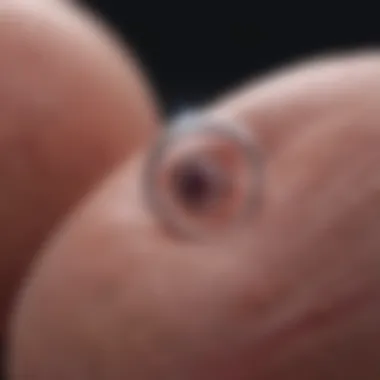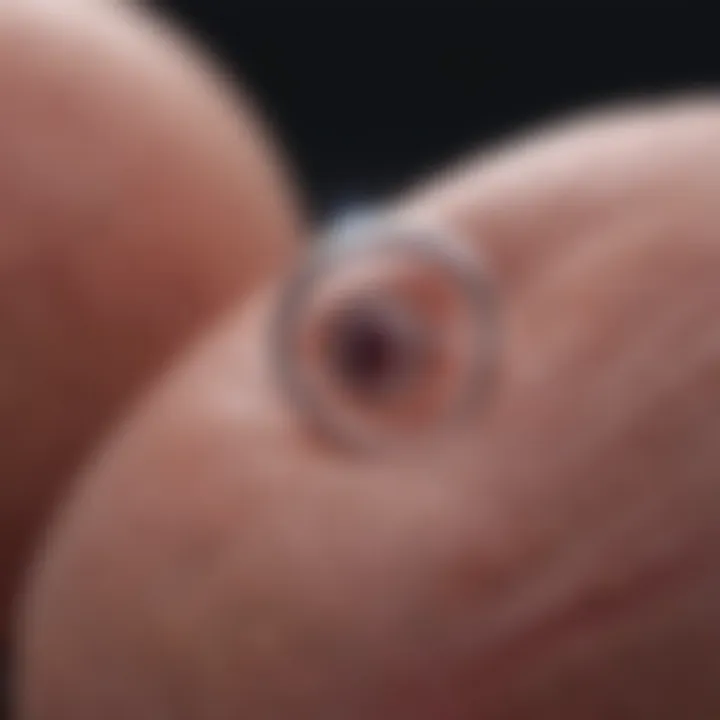Non-Surgical Vasectomy Reversal: Innovative Solutions


Summary of Objectives
This article attempts to investigate the landscape of vasectomy reversal through non-invasive techniques. The primary goal is to introduce and evaluate methods that promise to restore male fertility without the need for surgical intervention. Understanding these alternatives is critical for individuals considering fertility restoration after a vasectomy.
Importance of the Research
Given the rising interest in less invasive medical solutions, researching non-surgical vasectomy reversals holds significant relevance. For many men, surgery can be intimidating and accompanied by various risks, including complications and recovery time. By delving into these alternative methods, this work aims to illuminate their viability and enhance the decision-making process for those contemplating fertility restoration.
Prelims
Men who undergo a vasectomy may later find themselves reconsidering their decision, motivated by various personal, relational, or social factors. The desire to restore fertility can prompt them to look for options that may have fewer risks and complications than surgical reversals. In this context, non-invasive techniques are starting to gain traction, providing prospects for those who wish to regain fertility without the proverbial knife.
Results and Discussion
Presentation of Findings
Currently, the landscape of non-invasive vasectomy reversal is marked by innovative approaches. Three notable techniques are emerging:
- Sperm Retrieval Techniques: Methods such as percutaneous sperm retrieval are being explored, enabling collection of sperm directly from the testis without major surgery.
- Hormonal Therapy: Hormonal interventions can potentially stimulate spermatogenesis in men who have undergone a vasectomy, enhancing the likelihood of sperm production.
- Medical Devices: Advances in medical technology have led to the development of devices aimed at restoring vas deferens functionality non-surgically, although these are still largely experimental.
Each of these techniques has its own set of advantages and limitations. While sperm retrieval methods may provide immediate access to sperm for assisted reproduction technology, hormonal therapies require patient compliance and may take longer to show results.
Implications of Results
The advances in non-surgical vasectomy reversal techniques have significant implications for men seeking fertility restoration. Not only do these methods offer a lower-risk alternative to traditional surgeries, but they also broaden the scope of options available. However, these techniques are often in the early stages of development, meaning that comprehensive long-term studies are still lacking. Men considering these options should remain aware of the potential challenges and consult healthcare professionals who specialize in male reproductive health. Reflecting on this research provides a valuable framework for informed decision-making.
Understanding the challenges and benefits of non-surgical vasectomy reversal methods can help men make better choices about their reproductive health and future family planning.
Preamble to Vasectomy and Its Reversal
Vasectomy has become a popular choice for male contraception over the years, often lauded for its efficiency and relative simplicity. However, as life circumstances change—perhaps due to a new partner or the desire for additional children—some men find themselves contemplating a reversal. This is where this discussion becomes significant, especially when exploring alternatives to traditional surgical methods.
In essence, understanding vasectomy and its reversal is not merely about the mechanics of the procedure; it's about grappling with the emotional and relational intricacies that accompany such decisions. A vasectomy, a surgical procedure that cuts the vas deferens to prevent sperm from entering the ejaculate, can sometimes leave men feeling as though their options are permanently limited. This leads to the important question of how justifiable it is to consider reversal and the challenges faced during the decision-making process.
The significance of diving into the non-invasive methods of vasectomy reversal lies in the transformative potential these alternatives may offer. Unlike traditional surgeries, which often involve significant recovery times and risks, emerging techniques promise a less invasive approach, potentially making the prospect of fatherhood more accessible. The benefits of such methods speak for themselves: less physical trauma, shorter recovery periods, and, in some cases, a more acceptable emotional undertaking.
Moreover, the relevance of understanding these options is underscored by the evolving landscape of reproductive health technologies. It’s important to grasp the dimensions of these processes—not just from a medical perspective but also how they resonate on a personal and social level. This article endeavors to elucidate these aspects, serving as an essential resource for anyone navigating the complex terrain of fertility restoration.
“The journey toward understanding vasectomy reversal without surgery is as much about insights into one’s own life choices as it is about medical advancements.”
Understanding Vasectomy
Vasectomy, often misunderstood to be a complex procedure, is actually quite straightforward. The goal is simple: prevent sperm from mixing with semen. The vas deferens, the tube that carries sperm, is severed or blocked to achieve this. For many men, this becomes a clear-cut choice when they feel certain that they do not want children anymore. The procedure itself is minimally invasive, yet it comes with an emotional connotation that can feel heavy.
However, vasectomy does not mean, "I am done with fatherhood forever." Many men who undergo this procedure later find themselves reconsidering. Whether it’s due to changes in relationship status, a shift in personal desires, or even medical advice, there lies a chance to explore options for reversal.
Why Consider Reversal?
There are assorted reasons a man may contemplate a vasectomy reversal. Life is rarely stagnant, and personal scenarios can shift dramatically:
- New Relationships: A new partner may have different views on family, leading men to seek ways to restore their fertility.
- Desire for More Children: As familial situations evolve, men might find that they wish to have more children despite having chosen otherwise previously.
- Health Factors: Sometimes, health crises can alter priorities and stir the desire for parenthood into urgent consideration.
- Emotional Factors: The lingering emotional weight of a prior decision can encourage the exploration of alternatives to reconcile feelings of loss associated with childlessness.
Ultimately, reflecting on the reasons for considering a reversal is crucial. It helps individuals gauge their motivations more clearly and make well-informed decisions about how to proceed, whether through traditional surgical means or non-invasive alternatives that the current medical landscape offers.
Traditional Surgical Reversal Techniques


To understand the landscape of vasectomy reversal, one must first navigate the traditional surgical methods. These techniques have stood the test of time and remain relevant against the backdrop of emerging non-surgical alternatives. This section elucidates the key surgical options available, their benefits, and the important considerations that must be weighed when discussing surgical reversal.
Overview of Surgical Options
Surgical reversal of a vasectomy primarily encompasses two main techniques: vasovasostomy and vemectomy. Both procedures aim to reconnect the vas deferens, the tube that carries sperm from the testicles to the urethra, which is severed during a vasectomy.
- Vasovasostomy:
- Vasoepididymostomy:
- This is the most common approach. The surgeon reconnects the two ends of the vas deferens. The success of this method depends significantly on the time elapsed since the original vasectomy. Generally, the shorter the gap, the higher the success rate.
- The procedure often involves microsurgical techniques. Surgeons utilize magnification tools to stitch the delicate vas deferens, improving the chances of functional reconnection.
- This method is reserved for cases where vasovasostomy is not feasible, often due to a blockage in the epididymis. The surgeon performs a direct connection between the vas deferens and the epididymis. This procedure tends to be more complex and may have lower success rates compared to vasovasostomy.
Both methods are invasive and require a certain level of skill and expertise from the surgeon. The choice of technique largely depends on individual circumstances, including the patient's anatomy and the length of time since the initial vasectomy. Understanding these options provides a foundation for men considering surgical reversal, setting the stage for informed discussions about non-invasive alternatives.
Success Rates and Recovery
When diving into the effectiveness of surgical methods, success rates emerge as a crucial factor. Overall, vasovasostomy has a reported success rate ranging from 70% to 90%, depending on various factors:
- Time since vasectomy: The longer the time period, the more challenging the reversal may be. Success tends to diminish after a decade.
- Surgeon's skill: A well-experienced surgeon can significantly enhance the likelihood of success. This highlights the importance of not only the technique but the provider’s expertise.
In terms of recovery, after a standard surgical reversal:
- Patients typically can expect a healing period of around 7 to 14 days before resuming most normal activities. However, sexual activities are usually to be avoided for at least 4 to 6 weeks to ensure proper healing.
- The potential for complications exists, just as in any surgical procedure, ranging from infection to scarring that could impact future pregnancies.
It’s pivotal for patients to have a thorough consultation to understand not just the procedure but the realistic outcomes and timelines associated with recovery.
In summary, while traditional surgical techniques remain a viable route for vasectomy reversal, they come with their own sets of benefits and challenges. As the medical field evolves, many are left pondering whether non-surgical options could offer simpler alternatives without compromising on effectiveness or safety.
Emerging Non-Surgical Methods
The landscape of fertility restoration is no longer constrained to invasive surgical procedures. Emerging non-surgical techniques present an alternative that is gaining traction among individuals contemplating vasectomy reversal. As the conversation about fertility becomes more nuanced, these methods shine due to their potential for minimal discomfort and faster recovery. Traditional views about reproductive health are evolving, encouraging exploration beyond surgeries. This section delves into various non-invasive alternatives that provide hopeful paths for men seeking to regain fertility.
Intravaginal Techniques
Intravaginal techniques offer a fresh perspective in the realm of non-invasive vasectomy reversal alternatives. These methods typically involve injecting specialized solutions or using devices within the vaginal canal to target the vas deferens. The primary goal is to create an environment conducive to the regrowth or repair of sperm-carrying pathways.
Research suggests that these methods may boost local circulation and promote healing in the reproductive organs. One study showed positive outcomes in terms of sperm quality improvements among some participants. However, the effectiveness can vary widely—a reality that potential candidates should keep in mind. Individuals must also weigh the practicality and personal comfort level with using such methods, as they might not be suitable for everyone.
Use of Ultrasound Therapy
Ultrasound therapy is another non-invasive alternative that has emerged as a noteworthy contender in fertility restoration efforts. This technique uses sound waves to stimulate blood flow and tissue regeneration in the reproductive organs. Ultrasound has been widely recognized for its various therapeutic benefits, particularly in promoting healing and alleviating inflammation.
Several research initiatives have begun exploring how ultrasound can reinvigorate compromised sperm production following a vasectomy. Evidence indicates that the application of ultrasound waves can enhance the viability of sperm and improve overall reproductive health. Nevertheless, this method's effectiveness is still under review, and it may require supplementary treatments for optimization.
"Ultrasound therapy represents a promising frontier in non-surgical treatments, combining simplicity with compelling scientific insights."
Sperm Retrieval Innovations
In the realm of non-surgical means, sperm retrieval innovations represent a significant leap forward. Cutting-edge techniques like testicular sperm extraction and percutaneous sperm aspiration do not focus on reversing the vasectomy per se, but rather focus on retrieving viable sperm directly from the testis. This method holds promise for those who may not be able to restore sperm flow naturally.
What sets these innovations apart is their ability to acquire sperm even when traditional pathways remain blocked. Success rates for these methods vary, often depending on individual conditions, but they have provided new avenues for men looking to father children post-vasectomy. Overall, exploring these routes becomes essential for understanding the breadth of non-surgical options available today.
As men contemplate these emerging methods, it is crucial to also consider personal preferences, medical advice, and potential psychological impacts. Each option comes with its own set of advantages and limitations. The ongoing research in this domain indicates a future ripe with possibilities for improving reproductive health.
Comparative Analysis of Effectiveness
Understanding the comparative effectiveness of non-surgical versus surgical vasectomy reversal is critical for men weighing their options after a vasectomy. This analysis not only serves to highlight the functionality of these methods but also informs patients about realistic expectations regarding fertility restoration.


Non-Surgical vs Surgical Outcomes
When we look at the outcomes of surgical techniques like vasectomy reversals, it’s important to note that the conventional methods often boast higher success rates. Typically, surgical reversals report around 70% to 90% success when doctors perform the procedure under optimal circumstances. Non-surgical methods, while emerging, tend to lag this figure—yet they can be intriguing in their own right.
Non-surgical alternatives can be advantageous in terms of recovery time and overall patient discomfort. Pioneering treatments, such as ultrasound therapy and intravaginal techniques, can sometimes yield exciting results without the prolonged recovery periods associated with invasive procedures. It may surprise many that some studies have reported successful pregnancies from these non-invasive methods.
Nevertheless, with great power comes great responsibility. Individuals must understand that the effectiveness of non-surgical methods varies dramatically based on factors like age, underlying health, and the specifics of the original vasectomy.
In practical terms,
- Surgical Reversal: Higher success rates; longer recovery; proven reliability.
- Non-Surgical Methods: Offers less invasive options; quicker recovery times; emerging technologies with potential—caution advised on overall success metrics.
A patient considering these paths ought to engage thoroughly with medical professionals to assess their personal circumstances and the potential outcomes of various approaches.
Fertility Metrics and Measurements
To assess raw effectiveness, measurable metrics like sperm count, motility, and morphology become focal points. Traditional surgical reversals often show clear benefits in these areas due to more direct intervention. Non-surgical techniques, however, aim to restore these parameters indirectly. Research indicates that proper ultrasound therapy can enhance blood flow and subsequently improve sperm quality.
In line with this, here are some of the key fertility metrics to consider:
- Sperm Count: Measures the number of sperm present in a given volume of semen.
- Motility: Indicates the percentage of actively moving sperm, reflecting the likelihood of natural conception.
- Morphology: Assesses the shape and structure of sperm, which can correlate to its ability to fertilize an egg.
Ultimately, what it boils down to is the conversation between potential patients and their healthcare providers. Open dialogues about these parameters can aid in setting clear expectations regarding what each method might achieve and help men make a more informed choice.
"Not every path leads to the same destination; weigh your options carefully and let science guide you."
The effectiveness of either route hinges not only on the methodologies themselves but also significantly depends on personal health profiles. With well-informed discussions and an understanding of the latest research, individuals can take meaningful steps toward their reproductive goals.
Potential Risks and Considerations
When discussing non-surgical approaches to vasectomy reversal, it's vital to explore the potential risks and considerations involved. While these methods may offer a less invasive alternative, understanding the implications is crucial for anyone contemplating them.
The conversation around health risks and psychological impacts must be central to any discussion on non-surgical methods. It's not just about restoring fertility; it also encompasses the broader picture of a patient’s quality of life and well-being. Balancing hope for successful outcomes against potential complications helps set realistic expectations.
Health Risks Associated with Non-Surgical Methods
Despite the appeal of non-invasive options for reversing a vasectomy, there remain certain health risks worthy of consideration. These methods, while often less traumatic than surgery, are not without their own set of complications. Here are some notable risks:
- Infection: Non-surgical techniques like ultrasound therapy can still pose a risk of infection. While the skin may not be cut open, invasive devices may be used that can introduce bacteria.
- Incomplete Outcomes: Non-surgical methods do not always guarantee successful sperm recovery. Some men may find that even with advanced technology, the desired outcomes are not achieved, leaving them frustrated.
- Adverse Reactions: Individuals may experience unexpected side effects from certain therapies, such as severe discomfort or allergic reactions to medications used during these procedures.
- Long-Term Effects: Since many non-surgical techniques are relatively new, the long-term health consequences remain uncertain. As such, it is essential to proceed with caution and consult healthcare professionals.
"When exploring non-surgical options, always weigh the potential benefits against the risks and gather information from trusted healthcare sources."
Psychological Implications
Beyond the physical health considerations, the journey through non-surgical reversal methods can exhibit significant psychological implications. The process of wanting to restore fertility is inherently personal, often intertwined with emotions and expectations. Here are several psychological aspects to consider:
- Anxiety and Stress: The uncertainty of non-surgical outcomes can lead to increased anxiety. Men may find themselves anxious about whether they will achieve the desired result or about the implications of failure on their relationships.
- Expectations vs. Reality: Many individuals hold hopes that non-surgical methods will be nearly as effective as surgical options. When expectations are not met, it can lead to feelings of inadequacy and disappointment.
- Decision Fatigue: Choosing among various non-surgical options can be daunting. This process may result in decision fatigue, where endless choices lead to overwhelming stress and uncertainty.
- Support Systems: The role of emotional and social support during the non-surgical reversal process cannot be overstated. Having a supportive partner or community can provide crucial encouragement and understanding as men navigate their choices.
Navigating the potential risks and psychological implications is an important step for anyone involved in the conversation about non-surgical vasectomy reversals. Ultimately, creating an informed, well-rounded perspective will empower individuals to make the best decision for their unique circumstances.
Patient Perspectives and Testimonials
Understanding the role of patient experiences and testimonials is vital to gaining comprehensive insights into vasectomy reversal without surgery. When it comes to medical procedures, individual stories can illuminate just how impactful non-surgical options can be for those seeking fertility restoration. Moreover, these narratives bring to life the emotional aspects of navigating choices around reproductive health.
By prioritizing the perspectives of patients, we can appreciate not just the clinical outcomes, but also the personal journeys. Many men may enter the realm of vasectomy reversal apprehensive and uncertain, grappling with the implications of their choices. Hearing the stories of those who have pursued non-surgical methods can resonate deeply, fostering a sense of community and shared understanding. Here are a few key elements that underscore the significance of patient narratives in this field:
- Real-Life Experiences: Patient testimonials provide an authentic glimpse into the efficacy and challenges of non-surgical options. These accounts often include critical details about how different methods worked in practice, offering prospective patients valuable information.
- Emotional Aspects: Decisions about fertility can be emotionally charged. Personal stories frequently capture the angst, hope, and relief that accompany these choices, humanizing the discussion surrounding medical procedures.
- Informed Choices: Understanding patient satisfaction and what to expect from various techniques can help potential candidates make well-informed decisions. Insights from experiences can highlight what worked, what didn’t, and why, adding depth to clinical data.


Case Studies of Non-Surgical Approaches
Delving into specific case studies showcasing non-surgical vasectomy reversal methods can provide clarity on their effectiveness. For instance, one patient chose ultrasound therapy after feeling overwhelmed with the prospect of invasive surgery. Initially skeptical, he experienced a renewed hope after seeing positive outcomes highlighted in a peer-reviewed study.
In another case, a couple faced fertility challenges due to a previous vasectomy. They decided to utilize sperm retrieval innovations, hoping for the best. Post-treatment, they reported not only successful retrieval but also emotional satisfaction that exceeded their expectations. These cases illustrate that while results can vary, there is room for hope in the non-surgical avenue.
In addition to individual experiences, it’s important to track trends over time. Many reports indicate an increased interest in such methods, pointing towards a growing satisfaction rate among those opting for non-invasive solutions. Researching these trends, along with individual testimonials, allows us to paint a clearer picture of the potential impact of these approaches.
Patient Satisfaction and Follow-Up
Following up on patient satisfaction after non-surgical approaches is crucial. Many men who have explored these methods express a mixture of relief and gratification. They often cite minimal downtime compared to traditional surgical methods, which allows them to return to daily life much quickly.
Montgomery, who pursued ultrasound therapy, shared that the follow-up appointments were insightful and encouraging. He mentioned, "I was worried about recovery time, but I was back to my routine in no time. The follow-up checks eased my mind." This sentiment was echoed by others who reported feeling supported throughout the process.
Consider a few key aspects regarding follow-up:
- Monitoring Outcomes: Regular follow-up allows healthcare providers to evaluate the effectiveness of the procedure and make necessary adjustments based on patient feedback.
- Emotional Support: Reassurance through follow-up appointments fosters trust and continuity in care, helping patients feel connected to their healthcare professionals, which can be particularly important for emotional healing.
- Gathering Feedback: These interactions also serve as significant tools for ongoing research, as patient feedback can highlight areas for improvement and further innovation in non-surgical methods.
Ultimately, patient perspectives provide a human touch to the clinical landscape of vasectomy reversal, illustrating not only the successes but also the potential obstacles encountered along the way. They offer invaluable insight that can guide future research, patient education, and healthcare practices.
Future Directions in Vasectomy Reversal Research
The realm of vasectomy reversal research is evolving remarkably, uncovering potential pathways that could redefine fertility restoration. This section dives into what lies ahead, particularly focusing on the ongoing clinical trials and the technological innovations that might change the game. A closer look at these prospects not only enhances our understanding, but also provides hope for many men seeking alternatives to traditional surgical methods.
Ongoing Clinical Trials
Currently, numerous clinical trials are rolling out across various institutions, investigating both established and novel non-surgical techniques. These studies aim to rigorously assess the effectiveness of methods like intravaginal techniques and advanced sperm retrieval processes.
For example, one prominent trial focuses on the application of innovative ultrasound therapies. This approach seeks to stimulate the production of viable sperm without the need for surgery. Results from such trials may offer insights into the long-term viability of non-invasive treatments, paving the way for broader acceptance in the medical community.
Additionally, many trials examine the psychological aspects associated with non-surgical reversals, helping to gauge patient satisfaction and overall well-being post-treatment. Findings from these studies are critical, as they provide invaluable data on the comprehensive impact of these methods.
Potential Breakthroughs in Technology
The landscape of reproductive health is not static, and technological advancements continually reshape our approach to problems like vasectomy reversal. From enhanced imaging techniques to artificial intelligence applications in sperm analysis, the future looks promising.
- Microsurgery Robotics: Some researchers are exploring the integration of robotics in vasectomy reversal. This technology could allow for greater precision, even in non-invasive frameworks, ensuring that procedures are less intrusive while maintaining high success rates.
- Regenerative Medicine: There is burgeoning research into using stem cells and other regenerative therapies to facilitate sperm regeneration and repair reproductive function. This area holds the potential to revolutionize how men view their fertility options post-vasectomy.
"The future of non-surgical vasectomy reversal is not just about alternatives, but about creating solutions that are less invasive and more effective."
As these innovations develop, the obstacles faced by men after a vasectomy may become significantly smaller. Staying duly informed about these advancements is vital for patients and practitioners alike, allowing them to make educated choices regarding future fertility restoration methods.
In summary, the ongoing clinical trials and tech breakthroughs in vasectomy reversal research signal a shift towards more effective, safe, and less invasive options. As these efforts unfold, they bring with them hope and possibilities for those aiming to restore their fertility without the complications of surgical reversals.
Finale
The significance of understanding the various methods for non-surgical vasectomy reversal cannot be understated. As men consider their fertility options after a vasectomy, the insights offered by this exploration provide a foundation for informed decision-making. The allure of non-invasive methods—both from the health perspective and the psychological aspect—is growing.
Summary of Key Points
In summarizing key points, a few critical elements stand out:
- Innovative Non-Surgical Alternatives: The rise of techniques such as ultrasound therapy and intravaginal methods signals a paradigm shift in restoring male fertility. These approaches offer the possibility of addressing reproductive desires without the need for invasive surgery.
- Efficacy Compared to Traditional Methods: While surgical procedures like vasovasostomy usually have higher success rates, emerging non-surgical methods show promise in selectively restoring sperm mobility. These trends are worth noting for men who may feel daunted by the idea of undergoing surgery.
- Psychological and Health Considerations: Men opting for non-surgical routes often report reduced stress and anxiety regarding recovery. However, understanding the limitations of these techniques and the importance of having realistic expectations remains essential.
Final Thoughts on Non-Surgical Reversal
Ultimately, non-surgical vasectomy reversal alternatives present a significantly promising avenue for many men wishing to restore their fertility. As research progresses and more clinical studies become available, these methods are expected to continue evolving, offering higher success rates and safer procedures.
The importance of keeping abreast of these advancements cannot be overstated. As societal norms shift and discussions surrounding family planning become more open, awareness around these options will empower men and couples in their reproductive journeys. For those exploring their options, diving deep into the available research will offer not just data but possibly peace of mind in making such personal decisions.
"Understanding these non-invasive methods allows men to reclaim the conversation around their reproductive health."
As we consider the future of fertility restoration, it is evident that the landscape is changing. Informed decisions will lay the groundwork for progressive advancements, potentially revolutionizing how we view vasectomy reversal.















